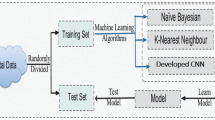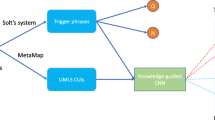Abstract
During recent years, maintaining scientific and medical databases has turned out to be a major challenge in the medical sector. The medical data regarding the patients comprise diverse diagnostic medical reports and features for such disease need to be recorded carefully for providing high-quality treatments. Therefore, this paper proposes a hybrid deep convolutional neural network (HDCNN)-based COOT approach to predict the risk of diseases. Initially, an improved crossover-based levy flight optimization algorithm (ICLFDO) algorithm is employed in selecting and processing the unstructured textual data. Then later, the HDCNN-COOT approach predicts the diseases more accurately. In addition to this, the classifier predicts whether the patient is at risk of disease in the future or not. The efficiency of the proposed model is evaluated by using a dataset obtained from University Hospital of Ludwig Maximilian University of Munich, Germany. The data collected in the data center include 29,477,035 data items from 36,082 patients. The proposed model is capable of using structured data and uses textual data of the patients. Finally, the higher classification accuracy and improved performance of the classifiers can be viewed using the experimental results conducted on five different datasets.






Similar content being viewed by others
Explore related subjects
Discover the latest articles, news and stories from top researchers in related subjects.Data availability
Data sharing is not applicable to this article as no new data were created or analyzed in this study.
Code availability
Not applicable.
References
Wang H, Zhang Q, Chen FY, Leung EYM, Wong ELY, Yeoh EK (2021) Tensor factorization-based prediction with an application to estimate the risk of chronic diseases. IEEE Intell Syst 36(6):53–61. https://doi.org/10.1109/MIS.2021.3071018
Chew WM, Loh CH, Jalali A, Fong GSE, Kumar LS, Sim RHZ, Tan RP, Gill SR, Liang TR, Koh JMK, Tay TR (2021) A risk prediction score to identify patients at low risk for COVID-19 infection. Med J 1:18
Gao Y, Cai GY, Fang W, Li HY, Wang SY, Chen L, Yu Y, Liu D, Xu S, Cui PF, Zeng SQ (2020) Machine learning based early warning system enables accurate mortality risk prediction for COVID-19. Nature communications 11(1):1–10. https://www.nature.com/articles/s41467-020-18684-2
Lo K, Huang YQ, Shen G, Huang JY, Liu L, Yu YL, Chen CL, Feng YQ (2021) Effects of waist to height ratio, waist circumference, body mass index on the risk of chronic diseases, all-cause, cardiovascular and cancer mortality. Postgrad Med J 97(1147):306–311. https://doi.org/10.1136/postgradmedj-2020-137542
Cohen S, Liu A, Wang F, Guo L, Brophy JM, Abrahamowicz M, Therrien J, Beauchesne LM, Bédard E, Grewal J, Khairy P (2021) Risk prediction models for heart failure admissions in adults with congenital heart disease. Int J Cardiol 322:149–157. https://doi.org/10.1016/j.ijcard.2020.08.039
Hongisto M, Lassus J, Tarvasmäki T, Sionis A, Sans-Rosello J, Tolppanen H, Kataja A, Jäntti T, Sabell T, Lindholm MG, Banaszewski M (2021) Mortality risk prediction in elderly patients with cardiogenic shock: results from the CardShock study. ESC heart failure 8(2):1398–1407. https://doi.org/10.1002/ehf2.13224
de la Varga-Martínez O, Gómez-Pesquera E, Muñoz-Moreno MF, Marcos-Vidal JM, López-Gómez A, Rodenas-Gómez F, Ramasco F, Álvarez-Refojo F, Tamayo E, Gómez-Sánchez E (2021) Development and validation of a delirium risk prediction preoperative model for cardiac surgery patients (DELIPRECAS): An observational multicentre study. J Clin Anesth 69:110158. https://doi.org/10.1016/j.jclinane.2020.110158
Irene DS, Sethukarasi T, Vadivelan N (2020) Heart disease prediction using hybrid fuzzy K-medoids attribute weighting method with DBN-KELM based regression model. Med Hypotheses 143: 110072
Shiny Irene D, Surya V, Kavitha D, Shankar R, John Justin Thangaraj S (2021) An intellectual methodology for secure health record mining and risk forecasting using clustering and graph-based classification. J Cir Syst Comput 30(8):2150135
Jose J, Gautam N, Tiwari M, Tiwari T, Suresh A, Sundararaj V, Rejeesh MR (2021) An image quality enhancement scheme employing adolescent identity search algorithm in the NSST domain for multimodal medical image fusion. Biomed Signal Process Control 66:102480
Sundararaj V (2016) An efficient threshold prediction scheme for wavelet based ECG signal noise reduction using variable step size firefly algorithm. Int J Intell Eng Syst 9(3):117–126
Irene DS, Sethukarasi T (2020) Efficient kernel extreme learning machine and neutrosophic c-means-based attribute weighting method for medical data classification. J Cir Syst Comput 29(16): 2050260
Inouye M, Abraham G, Nelson CP, Wood AM, Sweeting MJ, Dudbridge F, Lai FY, Kaptoge S, Brozynska M, Wang T, Ye S (2018) Genomic risk prediction of coronary artery disease in 480,000 adults: implications for primary prevention. J Am Coll Cardiol 72(16):1883–1893
Alaa AM, Bolton T, Di Angelantonio E, Rudd JH, Van der Schaar M (2019) Cardiovascular disease risk prediction using automated machine learning: a prospective study of 423,604 UK Biobank participants. PLoS ONE 14(5):e0213653. https://doi.org/10.1371/journal.pone.0213653
Zhou JH, Wei Y, Lyu YB, Duan J, Kang Q, Wang JN, Shi WY, Yin ZX, Zhao F, Qu YL, Liu L (2020) Prediction of 6-year incidence risk of chronic kidney disease in the elderly aged 65 years and older in 8 longevity areas in China. Zhonghua liu xing bing xue za zhi= Zhonghua liuxingbingxue zazhi, 41(1):pp.42–47
Hao Y, Usama M, Yang J, Hossain MS, Ghoneim A (2019) Recurrent convolutional neural network based multimodal disease risk prediction. Futur Gener Comput Syst 92:76–83
Chen M, Hao Y, Hwang K, Wang L, Wang L (2017) Disease prediction by machine learning over big data from healthcare communities. Ieee Access 5:8869–8879. https://doi.org/10.1109/ACCESS.2017.2694446
Priya L, Sathya A, Poornimathi K, Anitha J (2020) A Novel Intelligent Diagnosis and Disease Prediction Algorithm in Green Cloud Using Machine Learning Approach. J Green Eng 10:3421–3433
Nusinovici S, Tham YC, Yan MYC, Ting DSW, Li J, Sabanayagam C, Wong TY, Cheng CY (2020) Logistic regression was as good as machine learning for predicting major chronic diseases. J Clin Epidemiol 122:56–69. https://doi.org/10.1016/j.jclinepi.2020.03.002
Shankar V, Kumar V, Devagade U, Karanth V, Rohitaksha K (2020) Heart disease prediction using CNN algorithm. SN Comput Sci 1(3):1–8
Hegde S, Mundada MR (2020) Early prediction of chronic disease using an efficient machine learning algorithm through adaptive probabilistic divergence based feature selection approach. Int J Pervasive Comput Commu. https://doi.org/10.1108/IJPCC-04-2020-0018
Alloghani M, Al-Jumeily D, Hussain A, Liatsis P, Aljaaf AJ (2020) Performance-based prediction of chronic kidney disease using machine learning for high-risk cardiovascular disease patients. Nature-inspired computation in data mining and machine learning. Springer, Cham, pp 187–206
Hassan Mohammed K, El Desouky AI, Sally Elghamrawy M, Sarhan AM (2019) Hybrid Real-time remote monitoring framework with NB-WOA algorithm for patients with chronic diseases. Futur Gener Comput Syst 93:77–95
Abbaspour Onari M, Yousefi S, Rabieepour M, Alizadeh A, Jahangoshai Rezaee M (2021) A medical decision support system for predicting the severity level of COVID-19. Compl Intell Syst 7(4):1–15
Lakshmi C, Thenmozhi K, Rayappan JBB, Rajagopalan S, Amirtharajan R, Chidambaram N (2021) Neural-assisted image-dependent encryption scheme for medical image cloud storage. Neural Comput Appl 33(12):6671–6684
Maqsood S, Javed U (2020) Multi-modal medical image fusion based on two-scale image decomposition and sparse representation. Biomed Signal Process Control 57:101810. https://doi.org/10.1016/j.bspc.2019.101810
Liu Y, Cao B, Li H (2020) Improving ant colony optimization algorithm with epsilon greedy and Levy flight. Compl Intell Syst 7(4):1711–1722
Deng W, Xu J, Song Y, Zhao H (2021) Differential evolution algorithm with wavelet basis function and optimal mutation strategy for complex optimization problem. Appl Soft Comput 100:106724
Momeny M, Jahanbakhshi A, Jafarnezhad K, Zhang YD (2020) Accurate classification of cherry fruit using deep CNN based on hybrid pooling approach. Postharvest Biol Technol 166:111204
Naruei I, Keynia F (2021) A New Optimization Method Based on Coot Bird Natural Life Model. Expert Syst Appl 183:115352
Kumar V, Kumar D (2021) A systematic review on firefly algorithm: past, present, and future. Archives Comput Methods Eng 28(4):3269–3291
Maheshwari P, Sharma AK, Verma K (2021) Energy efficient cluster based routing protocol for WSN using butterfly optimization algorithm and ant colony optimization. Ad Hoc Netw 110:102317
Wang G, Guo L, Duan H, Wang H, Liu L, Shao M (2013) Hybridizing harmony search with biogeography based optimization for global numerical optimization. J Comput Theor Nanosci 10(10):2312–2322
Wang GG, Chang B, Zhang Z (2015) A multi-swarm bat algorithm for global optimization. In: 2015 IEEE congress on evolutionary computation (CEC). pp. 480–485
Funding
Not applicable.
Author information
Authors and Affiliations
Corresponding author
Ethics declarations
Conflict of interest
The authors declare that they have no conflict of interest.
Consent to participate
Not applicable.
Consent for publication
Not applicable.
Human and animal rights
This article does not contain any studies with human or animal subjects performed by any of the authors.
Additional information
Publisher's Note
Springer Nature remains neutral with regard to jurisdictional claims in published maps and institutional affiliations.
Rights and permissions
Springer Nature or its licensor holds exclusive rights to this article under a publishing agreement with the author(s) or other rightsholder(s); author self-archiving of the accepted manuscript version of this article is solely governed by the terms of such publishing agreement and applicable law.
About this article
Cite this article
Irene, D.S., Lakshmi, M., Kinol, A.M.J. et al. Improved deep convolutional neural network-based COOT optimization for multimodal disease risk prediction. Neural Comput & Applic 35, 1849–1862 (2023). https://doi.org/10.1007/s00521-022-07767-4
Received:
Accepted:
Published:
Issue Date:
DOI: https://doi.org/10.1007/s00521-022-07767-4




